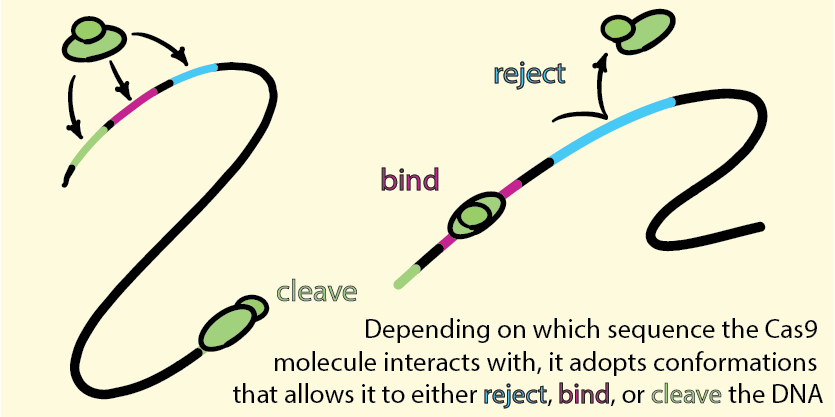
A multitude of biomolecular nano machines work in syncrony to sustain life in every living organism. Like the machines around us, the machines within use energy to do useful work and can so be understood in physical terms. In our group we focus on the machines that work on genomes. Machines that find, copy, move, proofread, repair, or even destroy genetic information. Our health depends on the work these machines do, and predicting their behaviour will impact both fundamental biological understanding and clinical applications.

The types of useful work a machine can do depends on the collection of conformational states it can transition between in response to external ques. As an example, consider a bacterial defence molecule Cas9 searching through a DNA pool in the hunt for viral sequences (Figure). Depending on the DNA seqeunce it interacts with (context), it adopts different structural configurations (states) to either reject and move on, bind stably, or cleave the DNA (functions). These intermolecular context-state-function relationships are what we model, as they are the key to constructing data-efficient and adaptable algoithms predicting biological behaviour.
At present, our research encompasses viral replication, DNA mismatch repair, and optimization, characterization, and prediction in the context of CRISPR-Cas based gene editing platforms.
The utility and joy of biophysical modelling
Most bioinformatic approaches to predicting whole-genome acticity of molecular machines are based on black-box machine learning or top-down heuristic classification schemes. By construction, such approaches are data hungry, non-adaptable to novel situations or training data, non-quantitative, and the results are largely uninformative beyond the specific classification they perform. By contrast, biophysical modelling is bottom up, starting at known physical law to adress the shortcomings of top-down bioinformatics, to yield quantitative and adaptable predictions.
Biophysics is also different from physical modelling of non-evolved systems. For non-evolved systems it makes little sence to answers "why?" questions along the lines of "For the purpose of ... ". For systems evolved through natural selection though, it can make sense to speak of purpose: The CRISPR immune system has developed for the purpose of fending off viruses; proofreading and DNA mismatch repair has evolved for the purpose of preserving the information content of the genome; and so on.
The oppertunity to think of natures evolved purpose is what sets biophysical apart from physical modelling of non-evolved systems.